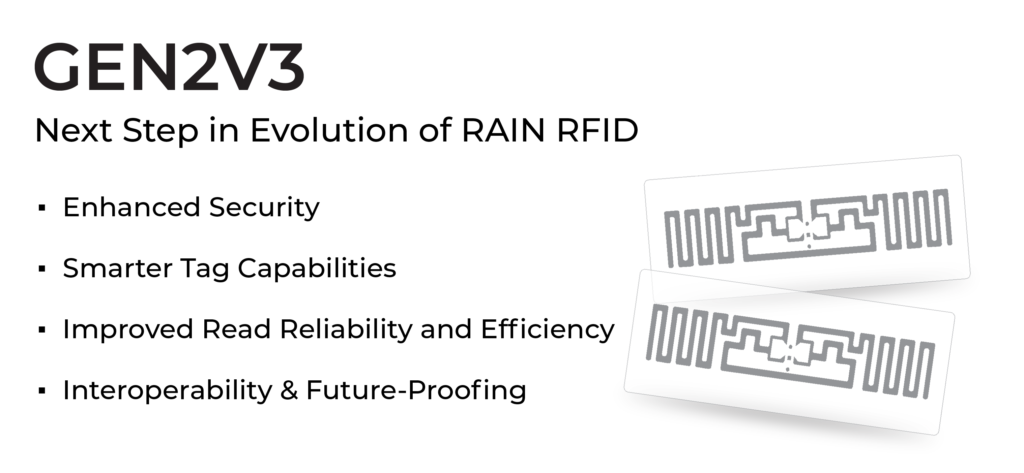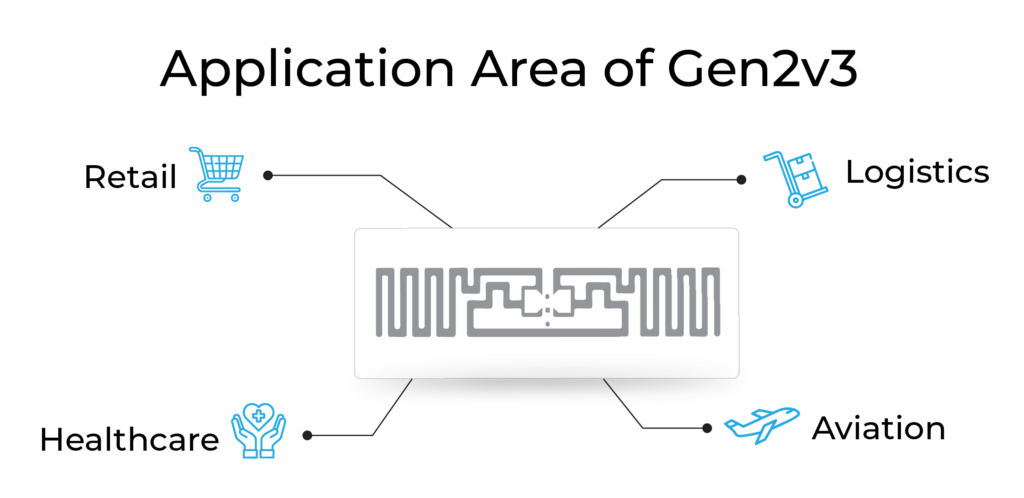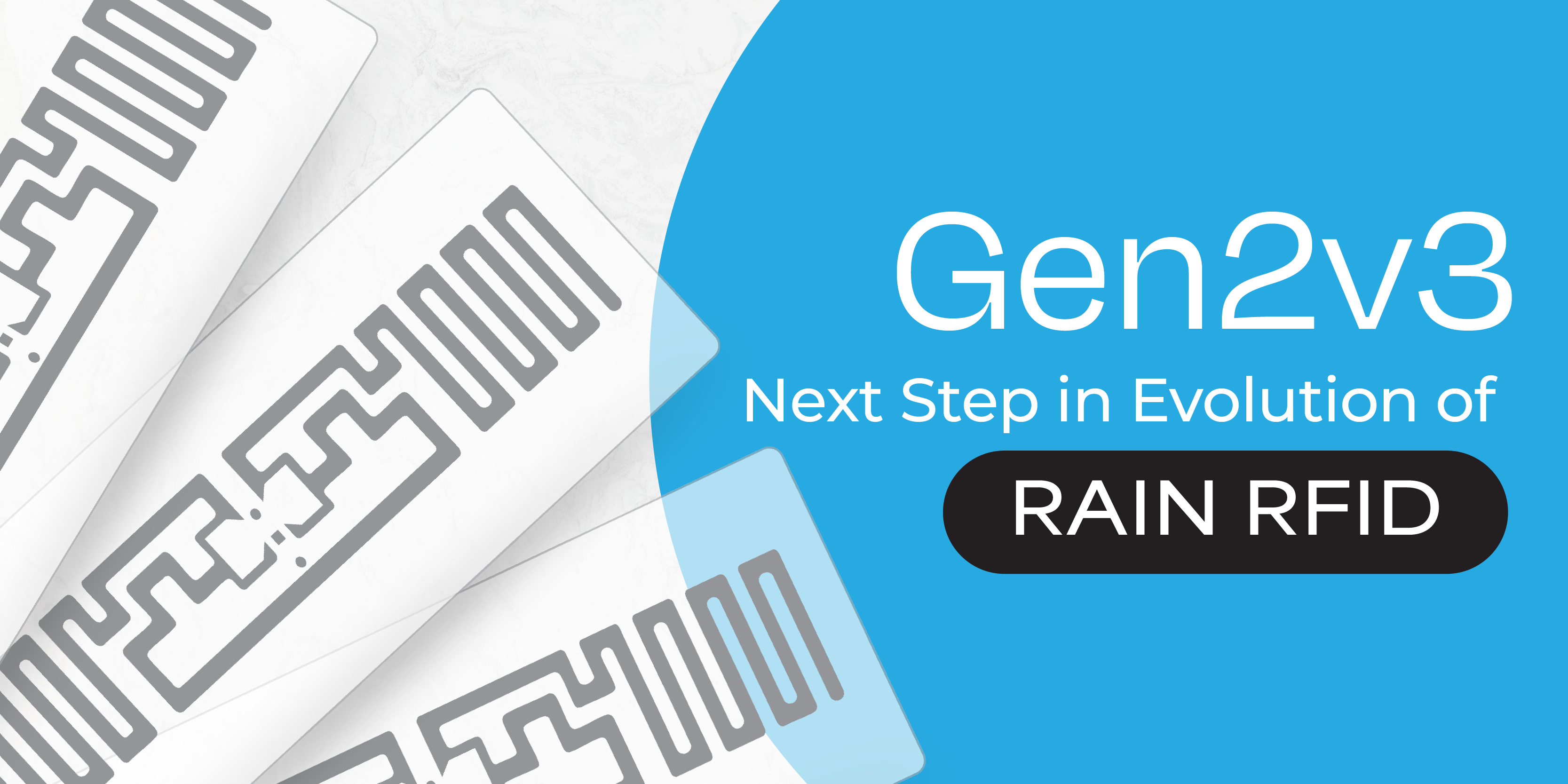As the world of RAIN RFID continues to expand, the technology behind it is evolving to meet growing demands. A major update is on the horizon: Gen2v3, the third version of the GS1 Electronic Product Code (EPC) UHF air-interface protocol. Expected to be ratified in early 2024, Gen2v3 is designed to improve the efficiency, accuracy, and scalability of RAIN RFID deployments.
This new specification responds to the increasingly complex environments in which RAIN RFID operates today. From single-reader setups to enterprise-scale systems with multiple readers and thousands of tagged items, the landscape has changed dramatically, and Gen2v3 aims to address these modern challenges.
The Journey of the Gen2 Protocol
The EPC Gen2 standard governs how passive RAIN RFID tags and readers communicate. Originally introduced to enable basic identification of items using radio waves, the protocol has undergone significant updates over the years to keep pace with technological advancements and real-world demands.
The last major revision, Gen2v2, was released in 2013. It brought important enhancements such as improved security and privacy. Now, more than a decade later, Gen2v3 builds on that foundation with new capabilities tailored for today’s more advanced, large-scale RFID applications.
GS1, the global standards body responsible for the EPC standard, works in collaboration with industry leaders, including Impinj, to ensure the protocol reflects current needs. This ongoing collaboration ensures that updates are consensus-driven and globally applicable.
Key Improvements in Gen2v3
Gen2v3 brings several enhancements focused on optimizing the interaction between tags and readers. These improvements are especially important for deployments where efficiency, accuracy, and scalability are critical. Here are the three most significant upgrades:
Managing Tag Clutter
As more items become RFID-enabled, environments are increasingly dense with tags. This can lead to “tag clutter,” where readers pick up signals from tags that are not relevant to the task at hand—such as tags from nearby systems or different use cases. Gen2v3 includes mechanisms to filter out these unwanted tags, allowing readers to focus only on the tags they’re meant to read. This leads to cleaner, more accurate data collection and minimizes interference.
Boosting Read Rates
A common challenge in RFID systems is dealing with “fringe” tags—those at the edge of the read zone that may not receive enough energy to respond properly. In previous versions, readers might waste time trying to communicate with these underpowered tags, slowing down the system. Gen2v3 introduces smarter handling, allowing readers to ignore incomplete tag responses. This significantly improves overall read performance and ensures more reliable data, especially in fast-paced inventory environments.
Optimizing Multi-Reader Deployments
Modern deployments often include several readers operating in close proximity, such as in a retail store with inventory readers in the back room, checkout readers at the front, and security readers at exits. Without proper coordination, these overlapping systems can confuse tag responses or cause duplicated reads. Gen2v3 addresses this with features that support seamless data collection across multiple readers, minimizing confusion and enhancing system-wide accuracy.
A Collaborative Development Effort
The creation of Gen2v3 is the result of collaborative work among more than 30 organizations, including solution providers, manufacturers, retailers, and logistics companies. The specification was shaped through a comprehensive development process under the guidance of GS1 and industry experts.
Before it is finalized, Gen2v3 will undergo a thorough peer review by the workgroup and a broader community review involving all GS1 members. Once ratified, the specification will be officially published by GS1.
What Comes Next?
Once Gen2v3 is officially released, RFID tag and reader manufacturers will begin integrating its features into their products. While using Gen2v3 is not mandatory, its improvements make adoption a smart move for companies seeking better performance from their RAIN RFID systems.
Importantly, Gen2v3 maintains backward compatibility. Systems running on Gen2v2 will continue to operate as usual, and there’s no disruption expected for existing deployments. This makes upgrading to Gen2v3 a low-risk, high-reward decision for most users.
Moving Forward Together
Impinj and its partners are committed to helping organizations take advantage of Gen2v3’s capabilities. Whether you’re a manufacturer, solution provider, or retailer, now is the time to start considering how Gen2v3 could fit into your RFID strategy.
Feedback is welcomed. How do you plan to use Gen2v3 in your systems? What features are most important to you? With your input, companies like Impinj can tailor product development to meet the real-world needs of businesses leveraging RAIN RFID.
What is Gen2v3?
Gen2v3 is the next-generation RAIN RFID standard currently under development by industry stakeholders and GS1. It introduces significant enhancements to tag functionality, reader interactions, and data security.

Key Features and Improvements of Gen2v3
Enhanced Security
- Improved tag authentication (potentially mutual authentication): Gen2v3 introduces more robust authentication protocols, possibly enabling mutual authentication where both the reader and the tag verify each other. This greatly reduces the risk of unauthorized access and makes eavesdropping or impersonation significantly harder.
- Support for modern cryptographic algorithms (e.g., AES or ECC): Unlike older RFID tags that used basic or proprietary security, Gen2v3 is expected to support strong, standardized cryptography like AES (Advanced Encryption Standard) and ECC (Elliptic Curve Cryptography). This ensures higher resistance to attacks such as brute-force decryption.
- More robust protection against tag cloning and spoofing: With advanced cryptography and authentication, Gen2v3 offers better safeguards against cloning (duplicating tag data) and spoofing (faking tag responses), thereby protecting the integrity of supply chains and high-value assets.
Smarter Tag Capabilities
- On-tag decision logic (edge intelligence): Tags may include logic to make simple decisions without involving a central reader or system, enabling distributed intelligence. For instance, a tag might only respond if a temperature threshold is exceeded, reducing system traffic and improving efficiency.
- More advanced sensor integration (e.g., temperature, motion, tamper): Gen2v3 supports richer integration with on-tag sensors. This allows tags to capture environmental or physical state data, such as detecting unauthorized movement, monitoring temperature-sensitive goods, or identifying tamper events.
- Support for advanced encoding schemes to reduce read errors: Enhanced data encoding improves the reliability of reads, even in noisy environments. This reduces the likelihood of data corruption and improves performance in dense tag scenarios or harsh industrial settings.
Improved Read Reliability and Efficiency
- Better handling of dense tag environments: Gen2v3 introduces smarter anti-collision protocols and faster inventory mechanisms to efficiently handle environments with thousands of tags, like large warehouses or retail stores.
- Adaptive modulation and coding for optimized reads under variable conditions: Tags can dynamically adjust how they communicate based on environmental factors such as interference or signal strength, leading to more reliable communication and faster read rates.
- Enhanced anti-collision and inventory management protocols: More sophisticated algorithms for managing simultaneous tag responses help prevent tag collisions and missed reads, enabling smoother and faster tag inventory sessions.
Expanded Memory and Data Handling
- Larger user memory partitions for storing dynamic data: Tags now offer significantly more user memory, allowing them to store complex data directly on the tag, such as maintenance logs, condition histories, or batch-specific metadata.
- Support for structured data formats (like JSON or TLV): Tags can store and transmit structured data using formats like JSON (JavaScript Object Notation) or TLV (Tag-Length-Value), which makes data parsing easier and more interoperable with modern IT systems.
- Improved file system models within tags for applications like logging: Gen2v3 may implement lightweight file system-like models to organize data on the tag, which is useful for applications needing sequential data storage, such as access logs or environmental tracking.
Interoperability & Future-Proofing
- Fully backward compatible with Gen2v2 and Gen2v1: Gen2v3 is designed to maintain compatibility with earlier standards, ensuring that existing RFID infrastructure (readers and software) can still operate effectively while benefiting from newer tag features.
- Designed to accommodate new types of tags, sensors, and devices: The standard is flexible enough to support emerging RFID hardware types, including smart labels, sensor-embedded tags, and even hybrid tags that combine RFID with other wireless technologies.
- Scalable for future IoT and edge computing integrations: Gen2v3 is architected to work seamlessly with future IoT applications, allowing RFID tags to act as edge nodes that contribute to real-time decision-making, analytics, and automation in connected environments.
Real-World Benefits of Gen2v3

| Application Area | Benefits of Gen2v3 |
|---|---|
| Retail | Accurate inventory, better theft prevention, dynamic pricing, real-time shelf monitoring |
| Logistics | Secure medication tracking, expiry alerts, temperature-logged tags |
| Aviation | Tamper detection on bags, authenticated parts, secure MRO tracking |
Why It Matters
As industries move toward automation, real-time analytics, and IoT-driven systems, Gen2v3 provides the infrastructure needed for RFID to evolve from passive ID tech to a more active, secure, and intelligent component of the connected ecosystem.
